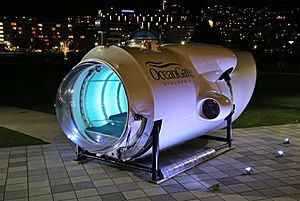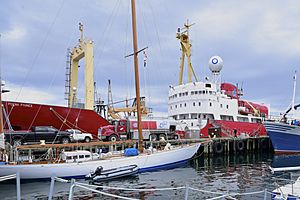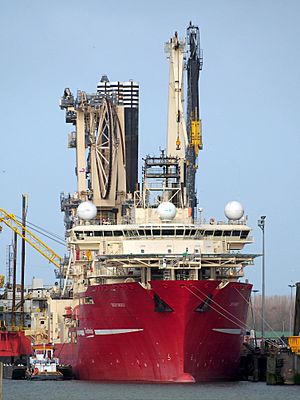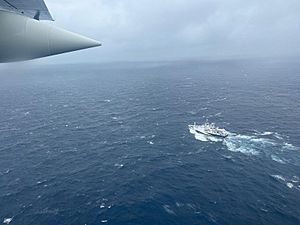Titan submersible implosion facts for kids
| Date | 18 June 2023 |
|---|---|
| Location | North Atlantic Ocean, near the wreck of the Titanic |
| Type | Maritime disaster |
| Cause | Failure of the pressure hull |
| Participants | 5 passengers |
| Outcome | Submersible destroyed by implosion |
| Deaths | 5 (see § Fatalities) |
On June 18, 2023, a special underwater vehicle called Titan disappeared. It was exploring the deep North Atlantic Ocean near Newfoundland, Canada. A submersible is like a small submarine. The Titan had five people inside. They were on an adventure to see the famous wreck of the RMS Titanic.
The Titan lost contact with its support ship about 1 hour and 45 minutes into its dive. It was supposed to return to the surface later that day. When it didn't, people realized something was wrong.
After a huge search that lasted almost 80 hours, a robot submarine found parts of the Titan. The pieces were about 488 meters (1,600 feet) away from the front of the Titanic. Experts believe the Titan's main body, called the pressure vessel, collapsed inwards very quickly. This is called an implosion. Everyone on board died instantly.
People had worried about the safety of the Titan before this trip. Many countries helped search for the missing submersible. Teams from the United States Coast Guard, United States Navy, and Canadian Coast Guard led the effort. Airplanes, ships, and underwater robots all joined the search.
Contents
People on Board the Titan
Five people were on the Titan submersible when it disappeared. They were:
- Stockton Rush: He was the pilot of the Titan. He was also the boss and founder of the company that owned the submersible, called OceanGate.
- Shahzada Dawood: A businessman from Pakistan and Britain.
- Suleman Dawood: Shahzada Dawood's 19-year-old son. He was a student.
- Hamish Harding: A British businessman and adventurer. He had done many amazing things, like going to the deepest part of the ocean (the Mariana Trench). He also flew into space in 2022.
- Paul-Henri Nargeolet: A former French Navy commander and a diver. He was a leading expert on the Titanic wreck. He had visited the wreck site more than 35 times.
About the Titan Submersible
The Titan was a special vehicle built to carry five people deep underwater. It was owned by a company called OceanGate, Inc.. The submersible was about 6.7 meters (22 feet) long and weighed about 10,432 kilograms (23,000 pounds).
The main part of the Titan that held the people was made from strong carbon fibre and titanium. It had a window that was about 380 millimeters (15 inches) wide. This window was made of a clear plastic called acrylic.
Interestingly, the Titan was controlled using a modified wireless game controller. It could move at about 3 knots (5.6 kilometers per hour) using four electric engines.
OceanGate had said that the Titan was designed with help from experts at NASA, Boeing, and the University of Washington. However, after the accident, these organizations said they were not involved in building or testing the Titan.
The Titan had systems to check how strong its body was while underwater. It also had enough air for five people to breathe for 96 hours. There was no navigation system inside the Titan. Instead, a support ship on the surface would send text messages to the Titan to guide it.
OceanGate also said the Titan had seven backup systems to help it return to the surface in an emergency. These included weights that could be dropped and a balloon that could inflate. Some systems were designed to work even if the people inside were unconscious. For example, sandbags were held by hooks that would dissolve in the water after a certain time, letting the Titan float up.
Trips to the Titanic Wreck
The Titan first visited the Titanic wreck in July 2021. It made more trips in 2022 and 2023.
Each trip usually had a pilot, three paying passengers, and a guide. Once everyone was inside, the hatch was bolted shut. It could only be opened from the outside. The journey down to the Titanic took about two hours. The whole trip usually lasted around eight hours.
During the dive, the Titan was supposed to send a safety signal every 15 minutes. This signal was monitored by the crew on the surface ship. The Titan and the surface crew could also send short text messages to each other.
Customers who went on these trips were called "mission specialists" by OceanGate. They paid US$250,000 for the eight-day adventure.
OceanGate had planned several dives to the Titanic in 2023. However, the trip where the Titan was lost was the only one that happened that year.
The Incident
On June 16, 2023, the trip to the Titanic wreck began. The support ship, MV Polar Prince, left St. John's, Newfoundland.
The ship arrived at the dive site on June 17. One of the passengers, Hamish Harding, shared on Facebook that bad weather had made this the only planned trip to the Titanic in 2023. He said they would try to dive the next day.
The dive started on June 18 at 9:30 a.m. Newfoundland Daylight Time. For the first hour and a half, the Titan communicated with the Polar Prince every 15 minutes. But at 11:15 a.m., communication stopped.
Later, a special listening system used by the U.S. Navy picked up a sound. This sound matched what an implosion would sound like. It happened hours after the Titan began its dive.
Filmmaker James Cameron, who has visited the Titanic wreck many times, suggested that the Titan's warning system might have told the passengers that the hull was about to break. He also said that it seemed they had tried to release their weights to come back up. Simulations show that the implosion happened in less than one second. This means everyone on board would have died instantly, without any pain.
Search and Rescue Efforts
The Titan was expected to resurface at 4:30 p.m. When it didn't, the U.S. Coast Guard was told about the missing vessel at 7:10 p.m. The U.S. Navy then shared the information about the possible implosion sound. The Titan had enough breathable air for 96 hours. This air supply would have run out on the morning of June 22 if the submersible had stayed in one piece.
The United States Coast Guard, United States Navy, and Canadian Coast Guard led the huge search and rescue mission. Airplanes from the Royal Canadian Air Force and the United States Air National Guard helped. A Royal Canadian Navy ship and many other commercial and research ships also joined. They used remotely operated underwater vehicles (ROVs), which are robots that can explore underwater. The search included looking on the surface and using sonar to listen underwater.
Crews from the U.S. Coast Guard searched an area about 900 nautical miles (1,667 kilometers) from Cape Cod, Massachusetts. Canadian aircraft and ships also joined the search. On June 19, three C-130 Hercules planes and a P-8 Poseidon anti-submarine warfare plane were used. They also dropped special listening devices called sonobuoys into the water. Bad weather made the search difficult at first, but it cleared up later.
Rear Admiral John Mauger of the U.S. Coast Guard explained that the search was hard because the area was so far away. The weather, darkness, and cold water also made it challenging. He said they were using "all available assets." Many submersibles have a special beacon that sends out sounds to help rescuers find them, but the Titan did not have one.
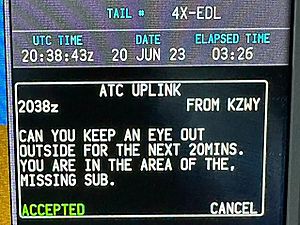
On June 20, a ship called Deep Energy arrived with two ROVs and other equipment for deep-sea work. By this time, the U.S. Coast Guard had searched an area of about 10,000 square miles (25,900 square kilometers).
A Canadian plane's sonar picked up some underwater noises. The U.S. Coast Guard looked into these sounds, but they later said the noises were probably not related to the missing Titan.
More ships and ROVs arrived on June 21 to help. These included the CCGS John Cabot, which had advanced sonar. Despite worries about the air supply running out, the U.S. Coast Guard said it was still a "search and rescue mission 100%," not just a recovery mission.
An Odysseus 6k ROV from Pelagic Research Services reached the sea floor and began searching. The French RV L'Atalante also deployed its ROV, Victor 6000, which can dive to depths of up to 6,000 meters (19,685 feet) and send images back to the surface.
Discovery of Debris
At 1:18 p.m. on June 22, the U.S. Coast Guard announced that a field of debris had been found. It was located near the Titanic wreck. The Odysseus 6k ROV found the debris after five hours of searching. It was later confirmed to be parts of the Titan submersible.
At a press conference at 4:30 p.m., the Coast Guard announced that the Titan had been lost due to an implosion of its pressure chamber. Pieces of the Titan were found on the sea floor about 500 meters (1,600 feet) northeast of the front of the Titanic.
The debris included the tail cone and parts of the pressure vessel that protected the crew. The pieces were spread out in two areas. Rear Admiral John Mauger said the debris showed a "catastrophic loss of the pressure chamber." This means the main body of the submersible had completely collapsed.
In the News
The Titan incident received a lot of attention from the news and the public. Some people, like former US President Barack Obama, pointed out that another disaster, the 2023 Messenia migrant boat disaster, which happened around the same time and involved many more deaths, received much less attention.
In 2024, a special TV show called Truth and Lies: Fatal Dive to the Titanic was made about the Titan implosion. A movie inspired by the event, called Locker, was also announced. In March 2024, a two-part documentary called "Minute by Minute: The Titan Sub Disaster" aired on BBC Channel 5.
See also
 In Spanish: Accidente del sumergible Titan para niños
In Spanish: Accidente del sumergible Titan para niños


